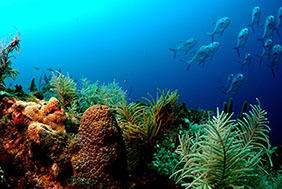-
Home
-
Data & Publications
-
Regional Portals
- About Regional Portals
- Florida
- Navassa Island
- Puerto Rico
- Flower Garden Banks
- U.S. Virgin Islands
- American Samoa
- Commonwealth of the Northern Mariana Islands
- Federated States of Micronesia
- Guam
- Main Hawaiian Islands
- Republic of the Marshall Islands
- Northwestern Hawaiian Islands
- Republic of Palau
- Pacific Remote Island Areas
-
CRCP Activities
- Glossary
Coral Reef Resilience to Climate Change in Guam in 2016

Introduction:
Coral reef resilience is the capacity of a reef to resist or recover from degradation and maintain provision of ecosystem goods and services. Resilience-based management (RBM) has been developed to overcome the challenges of supporting ecosystem resilience in this era of rapid change. RBM involves the application of resilience theory and tools to deliver ecosystem-based management outcomes into the future. RBM of coral reefs can include assessing spatial variation in resilience potential and then targeting and tailoring appropriate actions to preserve or restore the resilience of reefs. Resilience assessments involve measuring or assessing resilience indicators (e.g., coral disease, coral recruitment and herbivorous fish biomass) and producing an aggregate score that expresses resilience potential for all sites as relative to the site with the highest (assessed) resilience potential.
The Marine Fisheries Management Plan of Guam explains that understanding the resilience of reef fisheries and the coral reefs upon which they depend is needed for future assessments of yield. This project was designed to meet this need.
Objectives:
- Obj. 1 - Benthic Cover - Assess the percentage cover of major benthic groups, including corals, macroalgae, coralline algae, and 'other' (i.e., turf algae and unconsolidated substrate).
- Obj. 2 - Relative Resilience - Assess the relative resilience potential of coral reefs at two depths and compare resilience potential among survey sites.
- Obj. 3 - Resilience Drivers - Determine the drivers of differences in resilience potential between sites.
Results:
- Obj. 1 - Coral cover was higher on average in the shallow (25%) survey areas than the deep areas (19%). Differences between the shallow and deep survey sites in coral cover are driven by differences in macroalgae cover as coralline algae (12% shallow and 10% deep) and other cover (41% both depths) are very similar between the depths. Average macroalgae cover was 22% in the shallow and 30% in the deep.
- Obj. 2 - For the shallow sites, normalized resilience scores ranged from 0.62 to 1.00. Three sites were assessed as having high resilience, five medium-high, nine medium-low, and two low. The three sites with high relative resilience are Tagua Point, Ague Point, and Pugua Patch Reef; these sites are in northern Guam. The two sites with low relative resilience are Ga'an Point and Fouha Bay, which are in southwestern Guam. There is a strong pattern that the relative resilience classes for survey sites are higher in the northern half of Guam and lower in the southern half and this was true for both depths (see figure below). For both depths and with very few exceptions, scores were medium-high or high for resilience indicators in northern Guam and medium-low or low in southern Guam. For the deep sites, normalized resilience scores ranged from 0.64 to 1.00. Five sites were assessed as having high resilience, five medium-high, seven medium-low, and three low. The five sites with high relative resilience are Pugua Patch Reef, Ague Point, Luminao Reef, Tagua Point, and Tumon Bay; these sites are in northern Guam. The three sites with low relative resilience are Fouha Bay, Facpi Point and Cocos Barrier Reef-E, which are in southern Guam.
- Obj. 3 - Across the shallow reef sites of Guam, higher resilience potential correlated most strongly with high coral cover and high coral recruitment and low resilience potential sites were negatively correlated with these same two indicators. Across the deep reef sites of Guam, higher resilience potential correlated most strongly with high coral recruitment, low macroalgae, high herbivore biomass and high coral cover.

Next Steps:
Continued resilience monitoring can help managers identify the reefs that recover the fastest from recent bleaching events in Guam; these may be conservation priority areas. Combining the results of the Guam study with the CNMI study can help provide the groundwork for a regional planning and response. The data and results will be built into a Pacific-wide assessment of coral reef fisheries vulnerability to climate change being led by members of this project team from 2017-2019.
Site Summaries:
This report concludes with Site Summaries. These are 1-page summaries for each survey site that present the site name origin, and, for each site depth: coordinates, photographs, resilience ranks, resilience indicator scores, benthic community pie charts, and coral and fish species lists.
Citation:
Maynard, J., Johnson, S.M., Burdick, D.R., Jarrett, A., Gault, J., Idechong, J., Miller, R., Williams, G.J., Heron, S.F., Raymundo, L. (2017). Coral reef resilience to climate change in Guam in 2016. NOAA Coral Reef Conservation Program. NOAA Technical Memorandum CRCP 29, 51 pp.
Coral Reef Resilience to Climate Change in Guam in 2016: (full report, pdf 20.5 MB)


